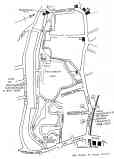
Heritage Weekend 17th September 2000 Members Guided Tour of Ravensbury Park. Ray Leyden
As Burns will have it "The best laid schemes of mice and men gang aft agley"! Our plan was for historian Eric Montague to spoil our members with a guided tour of Ravensbury Park, as an event to help celebrate the National Heritage Weekend.
However along came the petrol crisis which left our tour guide stranded on the South Coast. However contingency plans were implemented by Eric, affectionately known as Monty, who thoughtfully produced some brief notes and faxed them thru to yours truly Ray Leyden, which suddenly elevated me to Tour Guide. This is the remarkable story of how I did the Full Monty.
Stop 1. (Just inside the Wandle Road entrance to the Park)
A small group of us gathered together to commence the circular walk. At this time no one knew how long the petrol crisis would last, and the fact there were any of us there was a triumph . I tendered Monty's apologies, offered the notes for others to read, but, not surprisingly, there were no other takers to lead the walk. From the notes I was able to get us underway by confirming that the first documentary reference to Ravensbury Park dates to about 1220. A demesne farm lay at the heart of the estate in the 14th century, and a modern house, "Ravensbury Farmhouse" (but not a farm) still survives. Also a well was uncovered near the river bank when a tree was blown down in the storms of 1987.
Stop 2. (Across the bridge by the information board.)
Ravensbury Park today is roughly equal in extent to the grounds of Ravensbury House (the old manor house) in the 18'h century. In 1912 Harold F Bidder (the 1st President of the Merton Historical society) built his own house which he called "Ravensbury Manor." Later redevelopment followed break-up of the Bidder estate. Although the house was demolished steps were taken to buy the 16 or so acres left of the park and to preserve them as a public recreation ground. In its heyday, the Wandle here, which runs wide and smooth through the park, provided a popular boating area. We were interested to note the recent height of the river from strands of weed hanging from the lower branches of the trees along its edge..
Stop 3. (On or near the bridge upstream, close to the Watermeads Housing Estate)
The path alongside the river here is part of the Wandle Trail, running from mouth to source, a joint enterprise by the riparian Local Authorities. The bank on the Southern side of the river is "Happy Valley" bought by Richardson Evans of Wimbledon and given to the National Trust in 1915 in memory of Octavia Hill. A branch of the river runs off here into what looks like an old mill pond, but turns out to be an overflow area - part of the flood defences.
Stop 4. (Return downstream, stopping by the ruins of Ravensbury Manor)
| [Full size image 3.14kb] |
Stop 5. (Opposite the length of red brick wall)
The wall opposite is all that remains of the Ravensbury Print Works. On the way to our last stop we noted the backwater, created centuries ago to serve those works.
Stop 6. (By the pair of millstones on the river bank)
These are a very large pair of edge runners which were obtained by the Wandle Industrial Museum from a firm of spice grinders, Brome & Schimmer of Southwark. The stones are 5 foot in diameter and weigh 2 tons. They were installed by the Education, Leisure and Libraries Dept of London Borough of Merton and serve as a reminder of the river's industrial past, most appropriately for Ravensbury Mill which used the same type of wheel for the grinding of tobacco. A fitting place to end the tour as the mill is to be the new home for the Wandle Industrial Museum.
|
|
|
|